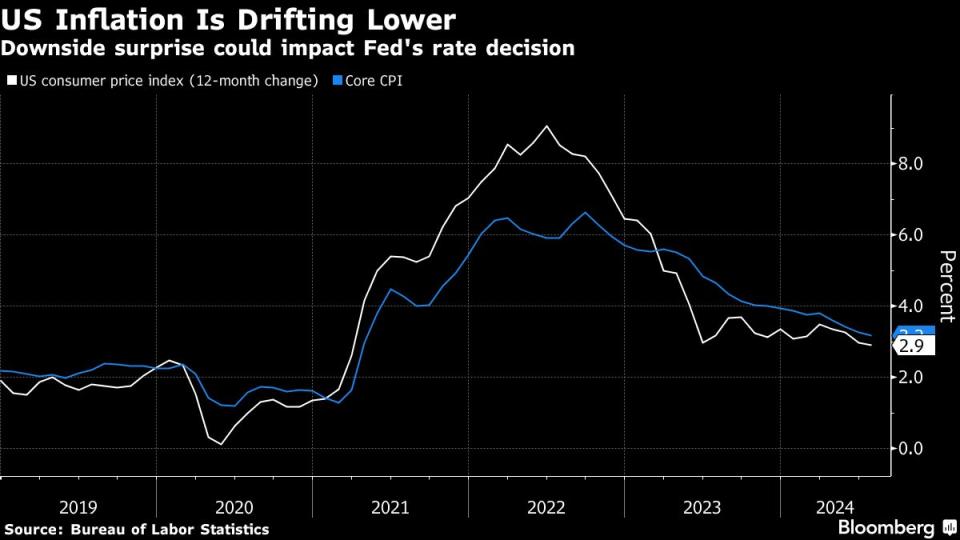US CPI to Show Another Muted Rise as Fed Debates Rate-Cut Size
(Bloomberg) -- Forecasters expect a monthly report on US consumer prices to show another month of muted increases, possibly playing into a Federal Reserve debate over how much to cut interest rates.
Most Read from Bloomberg
Chicago Halts Hiring as Deficit Tops $1 Billion Through 2025
UC Berkeley Gives Transfer Students a Purpose-Built Home on Campus
The figures, to be published Wednesday by the Bureau of Labor Statistics, will probably show the consumer price index and a “core” gauge excluding food and energy both rose 0.2% in August following similar advances in July, according to the median estimates in a Bloomberg survey.
That would represent a 3.2% gain on an annual basis for the core measure — a third of where the rate was two years ago.
Increases of that magnitude would likely keep Fed officials leaning toward a quarter-point rate cut at next week’s policy meeting, though downside surprises would probably boost investor bets on a half-point reduction.
“Inflation data are quickly taking a backseat to labor market data in terms of relevance for Fed policy decisions, but with an inconclusive August employment report, August CPI data could be impactful,” Citigroup Inc. economists Veronica Clark and Andrew Hollenhorst said in a Sept. 9 report previewing the numbers.
“Given building downside risks to the labor market and activity, the bar for a soft-enough CPI reading to price a larger start to rate cuts could be low,” they wrote.
Here are the key components to watch in the report:
Rents
Rental inflation is widely expected to come in lower in August after a bounce in July that was boosted by outsize increases in the West. Owners’ equivalent rent in that region rose 0.4% in July following two months of 0.1% advances, whereas the pace of OER increases moderated in each of the other three major regions.
That would put rental inflation back in the long-awaited downtrend that began in June. Because housing makes up the biggest portion of the CPI, a moderation in rent increases would provide scope for other services categories — like health care and airfares — to rebound a bit after unusual declines in July, without having much impact on overall inflation.
“The BLS’s all tenant regressed rent index (ATRR), the most reliable leading indicator in our view, points to disinflation in official rent inflation,” Nomura economists led by Aichi Amemiya said in a Sept. 5 preview of the numbers. “In addition, supply of rental apartment buildings remained elevated, making it unlikely for the underlying trend of rent inflation to reaccelerate in the near future.”
Car Insurance
Motor-vehicle insurance inflation has been a big contributor to elevated services inflation over the last two years, regularly posting monthly increases on the order of 1% to 2%. Now, there are signs that providers may begin scaling back the pace of price hikes in the months ahead.
“Rates filings seem to have started to decelerate in July, indicating that insurance companies are asking for less important premiums increases to regulators,” economists at Morgan Stanley led by Diego Anzoategui said in a Sept. 5 preview of the report. “We expect this trend to continue and see more meaningful deceleration in car insurance CPI the rest of the year.”
Within services, analysts are also keeping an eye on airline fares and hospital services prices after substantial declines in July, with many expecting a partial reversal in August.
Apparel
Core goods prices fell 0.3% in July — marking the 13th drop in 14 months — led by a decline in used-car prices. Analysts generally expect more modest decreases both for prices of core goods overall and for used cars in August.
What Bloomberg Economics Says...
“August’s CPI report will likely suggest firms are having difficulty passing higher input prices on to consumers — even as freight costs have risen. That suggests further margin compression down the line, with the possibility that firms resort to layoffs to cut costs.”
—Anna Wong and Chris Collins
To read the full note, click here
One other category to keep an eye on within the core goods basket is apparel, which notched the biggest price decline in July since the start of the year. Analysts are split on whether prices will drop again in August, which suggests any outsize moves could have an impact on the overall inflation reading relative to expectations.
Seasonal adjustment factors in particular pose downside risks for apparel prices in the August report after they boosted readings earlier in the year, Employ America Executive Director Skanda Amarnath said in a Sept. 10 note previewing the release.
Most Read from Bloomberg Businessweek
EV Leases Go as Low as $20 a Month to Help Dealers Clear Their Lots
The Covid Pandemic Left an Extra 13 Million Americans Single
Putting Olive Oil in a Squeeze Bottle Earned This Startup a Cult Following
‘They Have Stolen Our Business’: When You Leave Russia, Putin Sets the Terms
©2024 Bloomberg L.P.

